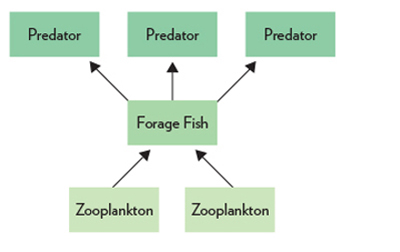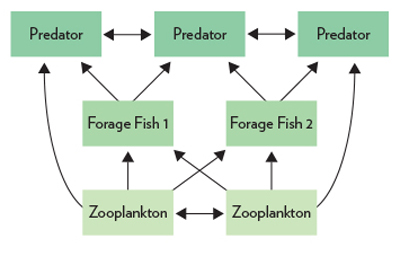New Research Points to the Need for Caution in Managing Forage Fish
A new study in the journal Ecological Applications provides the first direct, global estimate of the effects of harvesting small fish on their predators, including mammals, birds, and bigger fish.
Led by Pew marine fellows Tim Essington and Steve Munch, the research looked for indicators of when the harvest of these smaller species, often called forage fish, could have a significant impact on predators, including commercially valuable fish species. The authors found that existing ecosystem models offer no such indicators. They therefore recommend that managers be cautious in setting catch limits for forage species.
Recent studies have warned that catching too many forage fish may hurt populations of valuable predators. Notably, in 2012, the Lenfest Forage Fish Task Force, “found that the value of fisheries supported by forage fish (e.g., cod, striped bass, salmon, etc.) was twice the direct value of forage fish fisheries at a global scale.”
The new study by Essington and Munch is the first to take this to a local scale—using models of specific ecosystems to directly quantify the trade-offs between catching forage fish and leaving them as prey.
Approach
To assess the trade-offs, the authors compiled information on predator-prey relationships from mathematical models of 27 marine food webs. These models provided data on 594 predator-prey interactions in which the predators and their forage species were both targeted in fisheries.
The researchers used the models to predict how a small increase in the catch of each forage fish could affect the catch of each predator species. The change in predator catch (by weight) was then measured for the strength of the trade-off between catching forage fish and leaving them in the water.
The point of all this was to look for factors that might be used to predict the strength of the trade-off, such as the level of fishing on forage fish and predators, and the share of total forage fish mortality that each predator is responsible for. This predictive ability could help managers decide when fishing for forage species can be allowed and when it should be reduced or avoided.
Finally, the authors estimated how forage fish fishing would change the biomass of some groups of seabirds and marine mammals that feed on forage species. Such changes would not result in direct loss to fisheries.
Graphic: Two views of a food web. Marine food webs have often been depicted like Figure A below, divided into distinct layers of predators and prey, known as "trophic levels." But the reality is often more complicated, as depicted in Figure B, with predators eating from multiple tropic levels.
Figure A:

Figure B:

Trade-offs are difficult to predict
The study found that the highest likelihood of a large trade-off occurs when fishing intensity on forage species is high and when predators are responsible for a high share of the mortality of forage fish. But these conditions do not always result in a large trade-off. The researchers tried to find reliable indicators of strong trade-offs between catching forage fish and leaving them in the water, but they could not.
The primary reason for this is that interactions among predators and prey are not the same in all ecosystems. In some, predators eat mainly forage fish, while in others they are more omnivorous: They eat forage fish, other predators of forage fish, and even the young of their own species. Therefore, fishing for forage fish sometimes harms a predator by reducing its food supply and sometimes helps it by lessening its competition.
Additionally, many forage fish predators eat some of the same prey as forage fish, particularly when the predators are young. This sometimes lessens the negative effects of fishing for forage fish because there is subsequently more food for the juvenile predator fish. The net result of these complex connections depends on the configuration of each ecosystem.
Lastly, the study finds that the impact of forage fish catch is predictable in the case of marine mammals and birds. Even a small increase in forage fish catch produced large declines in the abundance of these species most of the time (up to 70 percent of the time).
Proceed with caution
Essington and Munch recommend precautionary approaches to managing forage fisheries due to the extreme difficulty in predicting the outcome of fishing on predators. Simply lowering fishing rates on forage fish species reduces the likelihood of strong ecological and economic trade-offs.








